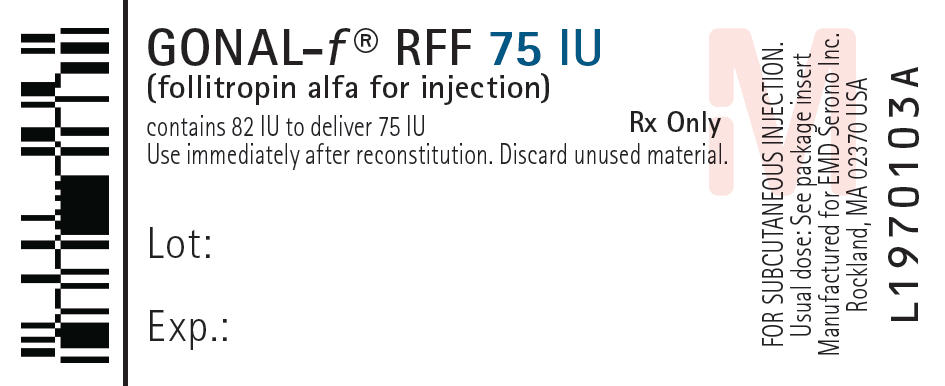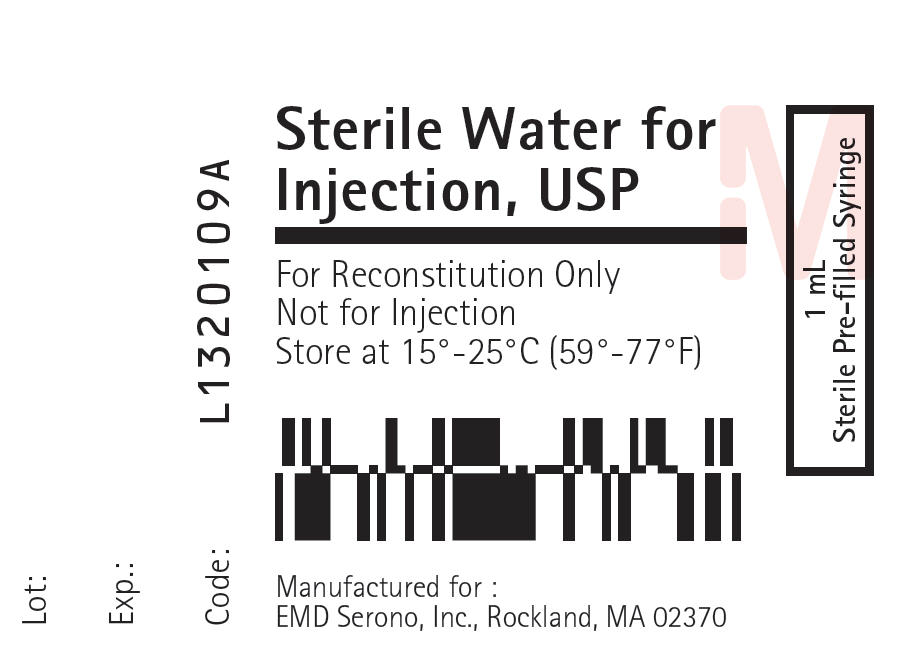GONAL-F RFF- follitropin alfa kit
GONAL-F RFF by
Drug Labeling and Warnings
GONAL-F RFF by is a Prescription medication manufactured, distributed, or labeled by EMD Serono, Inc.. Drug facts, warnings, and ingredients follow.
Drug Details [pdf]
- SPL UNCLASSIFIED SECTION
-
DESCRIPTION
Gonal-f® RFF (follitropin alfa for injection) is a human follicle stimulating hormone (FSH) preparation of recombinant DNA origin, which consists of two non-covalently linked, non-identical glycoproteins designated as the α- and β-subunits. The α- and β-subunits have 92 and 111 amino acids, respectively, and their primary and tertiary structure are indistinguishable from those of human follicle stimulating hormone. Recombinant FSH production occurs in genetically modified Chinese Hamster Ovary (CHO) cells cultured in bioreactors. Purification by immunochromatography using an antibody specifically binding FSH results in a highly purified preparation with a consistent FSH isoform profile, and a high specific activity. The biological activity of follitropin alfa is determined by measuring the increase in ovary weight in female rats. The in vivo biological activity of follitropin alfa has been calibrated against the first International Standard for recombinant human follicle stimulating hormone established in 1995 by the Expert Committee on Biological Standards of the World Health Organization. Gonal-f® RFF contains no luteinizing hormone (LH) activity. Based on available data derived from physico-chemical tests and bioassays, follitropin alfa and follitropin beta, another recombinant follicle stimulating hormone product, are indistinguishable.
Gonal-f® RFF is a sterile, lyophilized powder intended for subcutaneous injection after reconstitution.
Each Gonal-f® RFF single-dose vial is filled with 82 IU (6 μg) follitropin alfa to deliver 75 IU (5.5 μg) and contains 30 mg sucrose, 1.11 mg dibasic sodium phosphate dihydrate, 0.45 mg monobasic sodium phosphate monohydrate, 0.1 mg methionine, and 0.05 mg polysorbate 20. Phosphoric acid and/or sodium hydroxide may be used prior to lyophilization for pH adjustment. Vials are reconstituted with Sterile Water for Injection, USP.
Under current storage conditions, Gonal-f® RFF may contain up to 10% of oxidized follitropin alfa.
Therapeutic Class: Infertility
-
CLINICAL PHARMACOLOGY
Gonal-f® RFF (follitropin alfa for injection) stimulates ovarian follicular growth in women who do not have primary ovarian failure. FSH, the active component of Gonal-f® RFF is the primary hormone responsible for follicular recruitment and development. In order to effect final maturation of the follicle and ovulation in the absence of an endogenous LH surge, human chorionic gonadotropin (hCG) must be given following the administration of Gonal-f® RFF when monitoring of the patient indicates that sufficient follicular development has occurred. There is interpatient variability in response to FSH administration.
Pharmacokinetics
Single-dose pharmacokinetics of follitropin alfa were determined following subcutaneous administration of 300 IU Gonal-f® RFF to 21 pre-menopausal healthy female volunteers who were pituitary down-regulated with a GnRH agonist.
The descriptive statistics for the pharmacokinetic parameters are presented in Table 1.
Table 1: Pharmacokinetic parameters of FSH following administration of Gonal-f® RFF Population Dose (IU) Healthy Volunteers (n=21) 300 IU SC in a single dose Mean %CV Abbreviations are: Cmax: peak concentration (above baseline); tmax : time of Cmax; t1/2: elimination half life AUClast (IU∙hr/L) 884 20% Cmax (IU/L) 9.83 23% tmax (hr) 15.5 43% t1/2 (hr) 53 52% Special populations
Safety, efficacy, and pharmacokinetics of Gonal-f® RFF in patients with renal or hepatic insufficiency have not been established.
Clinical Studies
The safety and efficacy of Gonal-f® RFF have been examined in two clinical studies: one study (Study 22240) for ovulation induction and one study (Study 21884) for assisted reproductive technologies (ART).
1. Ovulation Induction (OI)
Study 22240 was a phase III, assessor-blind, randomized, comparative, multinational, multicenter study in oligo-anovulatory infertile women undergoing ovulation induction. Patients were randomized to either Gonal-f® RFF (n=83), administered subcutaneously, or a comparator recombinant human FSH. The use of insulin-sensitizing agents was allowed during the study. Efficacy was assessed using the mean ovulation rate in the first cycle of treatment. The cycle 1 ovulation rate (primary outcome) for Gonal-f® RFF is presented in Table 2. Additionally, this table includes cumulative secondary outcome results from cycle 1 through 3. Study 22240 was not powered to demonstrate differences in these secondary outcomes.
Table 2: Cumulative Ovulation and Clinical Pregnancy Rates in Ovulation Induction Study 22240 Gonal-f® RFF
(n=83)- * Cumulative rates were determined per patient over cycles 1, 2, and 3.
- † Non-inferior to comparator recombinant human FSH based on a two-sided 95% confidence interval, intent-to-treat analysis.
- ‡ Secondary efficacy parameter. Study 22240 was not powered to demonstrate differences in this parameter.
- § A clinical pregnancy was defined as a pregnancy during which a fetal sac (with or without heart activity) was visualized by ultrasound on day 34-36 after hCG administration.
Cumulative* Ovulation Rate Cycle 1 72%† Cycle 2 89%‡ Cycle 3 92%‡ Cumulative* Clinical Pregnancy§ Rate Cycle 1 28%‡ Cycle 2 41%‡ Cycle 3 45%‡ 2. Assisted Reproductive Technologies (ART)
Study 21884 was a phase III, assessor-blind, randomized, comparative, multinational, multicenter study in ovulatory, infertile women undergoing stimulation of multiple follicles for Assisted Reproductive Technologies (ART) after pituitary down-regulation with a GnRH agonist. Patients were randomized to either Gonal-f® RFF (n=237), administered subcutaneously, or a comparator recombinant human FSH. Randomization was stratified by insemination technique [conventional in vitro fertilization (IVF) vs. intra-cytoplasmic sperm injection (ICSI)]. Efficacy was assessed using the mean number of fertilized oocytes the day after insemination. The initial doses of Gonal-f® RFF were 150 IU a day for patients < 35 years old and 225 IU for patients ≥ 35 years old. The maximal dose allowed for both age groups was 450 IU per day. Treatment outcomes for Gonal-f® RFF are summarized in Table 3.
Table 3: Treatment Outcomes in ART Study 21884 Gonal-f® RFF
value (n)- * Non-inferior to comparator recombinant human FSH based on a two-sided 95% confidence interval, intent-to-treat analysis
- † Study 21884 was not powered to demonstrate differences in subgroups
- ‡ A clinical pregnancy was defined as a pregnancy during which a fetal sac (with or without heart activity) was visualized by ultrasound on day 35-42 after hCG administration.
- § Secondary efficacy parameter. Study 21884 was not powered to demonstrate differences in this parameter
Mean number of 2PN oocytes per patient 6.3 (237)* Mean number of 2PN oocytes per patient receiving IVF 6.1 (88)† Mean number of 2PN oocytes per patient receiving ICSI 6.5 (132)† Clinical pregnancy‡ rate per attempt 33.5% (218)§ Clinical pregnancy‡ rate per embryo transfer 35.8% (204)§ Mean treatment duration in days (range) 9.7 [3-21] (230)§ -
INDICATIONS AND USAGE
Gonal-f® RFF (follitropin alfa for injection) is indicated for the induction of ovulation and pregnancy in the oligo-anovulatory infertile patient in whom the cause of infertility is functional and not due to primary ovarian failure. Gonal-f® RFF is also indicated for the development of multiple follicles in the ovulatory patient participating in an Assisted Reproductive Technology (ART) program.
Selection of Patients
- Before treatment with Gonal-f® RFF is instituted, a thorough gynecologic and endocrinologic evaluation must be performed. This should include an assessment of pelvic anatomy. Patients with tubal obstruction should receive Gonal-f® RFF only if enrolled in an in vitro fertilization program.
- Primary ovarian failure should be excluded by the determination of gonadotropin levels.
- Appropriate evaluation should be performed to exclude pregnancy.
- Patients in later reproductive life have a greater predisposition to endometrial carcinoma as well as a higher incidence of anovulatory disorders. A thorough diagnostic evaluation should always be performed in patients who demonstrate abnormal uterine bleeding or other signs of endometrial abnormalities before starting Gonal-f® RFF therapy.
- Evaluation of the partner's fertility potential should be included in the initial evaluation.
-
CONTRAINDICATIONS
Gonal-f® RFF (follitropin alfa for injection) is contraindicated in women who exhibit:
- Prior hypersensitivity to recombinant FSH preparations or one of their excipients.
- High levels of FSH indicating primary gonadal failure.
- Uncontrolled thyroid or adrenal dysfunction.
- Sex hormone dependent tumors of the reproductive tract and accessory organs.
- An organic intracranial lesion such as a pituitary tumor.
- Abnormal uterine bleeding of undetermined origin (see "Selection of Patients").
- Ovarian cyst or enlargement of undetermined origin (see "Selection of Patients").
- Pregnancy.
-
WARNINGS
Gonal-f® RFF (follitropin alfa for injection) should only be used by physicians who are thoroughly familiar with infertility problems and their management. Gonal-f® RFF is a potent gonadotropic substance capable of causing Ovarian Hyperstimulation Syndrome (OHSS) in women with or without pulmonary or vascular complications. Gonadotropin therapy requires a certain time commitment by physicians and supportive health professionals, and requires the availability of appropriate monitoring facilities (see "Precautions/Laboratory Tests"). Safe and effective use of Gonal-f® RFF in women requires monitoring of ovarian response with serum estradiol and vaginal ultrasound on a regular basis. The lowest effective dose should be used.
Overstimulation of the Ovary During FSH Therapy
Ovarian Enlargement
Mild to moderate uncomplicated ovarian enlargement which may be accompanied by abdominal distention and/ or abdominal pain occurs in approximately 20% of those treated with urofollitropin and hCG, and generally regresses without treatment within two or three weeks. Careful monitoring of ovarian response can further minimize the risk of overstimulation.
If the ovaries are abnormally enlarged on the last day of Gonal-f® RFF therapy, hCG should not be administered in this course of therapy. This will reduce the chances of development of Ovarian Hyperstimulation Syndrome.
Ovarian Hyperstimulation Syndrome (OHSS)
OHSS is a medical event distinct from uncomplicated ovarian enlargement. Severe OHSS may progress rapidly (within 24 hours to several days) to become a serious medical event. It is characterized by an apparent dramatic increase in vascular permeability which can result in a rapid accumulation of fluid in the peritoneal cavity, thorax, and potentially, the pericardium. The early warning signs of development of OHSS are severe pelvic pain, nausea, vomiting, and weight gain. The following symptomatology has been seen with cases of OHSS: abdominal pain, abdominal distension, gastrointestinal symptoms including nausea, vomiting and diarrhea, severe ovarian enlargement, weight gain, dyspnea, and oliguria. Clinical evaluation may reveal hypovolemia, hemoconcentration, electrolyte imbalances, ascites, hemoperitoneum, pleural effusions, hydrothorax, acute pulmonary distress, and thromboembolic events (see "Pulmonary and Vascular Complications"). Transient liver function test abnormalities suggestive of hepatic dysfunction, which may be accompanied by morphologic changes on liver biopsy, have been reported in association with Ovarian Hyperstimulation Syndrome (OHSS).
OHSS occurred in 6 of 83 (7.2%) Gonal-f® RFF treated women in Study 22240 (ovulation induction); none were classified as severe. In Study 21884 (ART), OHSS occurred in 11 of 237 (4.6%) Gonal-f® RFF treated women and 1 (0.42%) was classified as severe. OHSS may be more severe and more protracted if pregnancy occurs. OHSS develops rapidly; therefore, patients should be followed for at least two weeks after hCG administration. Most often, OHSS occurs after treatment has been discontinued and reaches its maximum at about seven to ten days following treatment. Usually, OHSS resolves spontaneously with the onset of menses. If there is evidence that OHSS may be developing prior to hCG administration (see "Precautions / Laboratory Tests"), the hCG must be withheld.
If severe OHSS occurs, treatment must be stopped and the patient should be hospitalized. A physician experienced in the management of this syndrome, or who is experienced in the management of fluid and electrolyte imbalances should be consulted.
Pulmonary and Vascular Complications
Serious pulmonary conditions (e.g., atelectasis, acute respiratory distress syndrome and exacerbation of asthma) have been reported. In addition, thromboembolic events both in association with, and separate from Ovarian Hyperstimulation Syndrome have been reported with gonadotropins including Gonal-f® RFF. Intravascular thrombosis and embolism can result in reduced blood flow to critical organs or the extremities. Sequelae of such events have included venous thrombophlebitis, pulmonary embolism, pulmonary infarction, cerebral vascular occlusion (stroke), and arterial occlusion resulting in loss of limb. In rare cases, pulmonary complications and/or thromboembolic events have resulted in death.
Multiple Births
Reports of multiple births have been associated with Gonal-f® RFF treatment. In Study 22240 for women receiving Gonal-f® RFF over three treatment cycles, 20% of live births were multiple births. In Study 21884, 35.1% of live births were multiple births in women receiving Gonal-f® RFF. The rate of multiple births is dependent on the number of embryos transferred. The patient should be advised of the potential risk of multiple births before starting treatment.
-
PRECAUTIONS
General
Careful attention should be given to the diagnosis of infertility in candidates for Gonal-f® RFF (follitropin alfa for injection) therapy (see "Indications and Usage/ Selection of Patients").
Information for Patients
Prior to therapy with Gonal-f® RFF, patients should be informed of the duration of treatment and monitoring of their condition that will be required. The risks of ovarian hyperstimulation syndrome and multiple births in women (see WARNINGS) and other possible adverse reactions (see "Adverse Reactions") should also be discussed.
See DOSAGE AND ADMINISTRATION for "PATIENT INSTRUCTIONS FOR USE OF GONAL-F® RFF".
Laboratory Tests
In most instances, treatment of women with Gonal-f® RFF results only in follicular recruitment and development. In the absence of an endogenous LH surge, hCG is given when monitoring of the patient indicates that sufficient follicular development has occurred. This may be estimated by ultrasound alone or in combination with measurement of serum estradiol levels. The combination of both ultrasound and serum estradiol measurement are useful for monitoring the development of follicles, for timing of the ovulatory trigger, as well as for detecting ovarian enlargement and minimizing the risk of the Ovarian Hyperstimulation Syndrome and multiple gestation. It is recommended that the number of growing follicles be confirmed using ultrasonography because plasma estrogens do not give an indication of the size or number of follicles.
The clinical confirmation of ovulation, with the exception of pregnancy, is obtained by direct and indirect indices of progesterone production. The indices most generally used are as follows:
- A rise in basal body temperature;
- Increase in serum progesterone; and
- Menstruation following a shift in basal body temperature.
When used in conjunction with the indices of progesterone production, sonographic visualization of the ovaries will assist in determining if ovulation has occurred. Sonographic evidence of ovulation may include the following:
- Fluid in the cul-de-sac;
- Ovarian stigmata;
- Collapsed follicle; and
- Secretory endometrium.
Accurate interpretation of the indices of follicle development and maturation require a physician who is experienced in the interpretation of these tests.
Carcinogenesis, Mutagenesis, Impairment of Fertility
Long-term studies in animals have not been performed to evaluate the carcinogenic potential of Gonal-f® RFF. However, follitropin alfa showed no mutagenic activity in a series of tests performed to evaluate its potential genetic toxicity including, bacterial and mammalian cell mutation tests, a chromosomal aberration test and a micronucleus test.
Impaired fertility has been reported in rats, exposed to pharmacological doses of follitropin alfa (≥40 IU/kg/day) for extended periods, through reduced fecundity.
Nursing Mothers
It is not known whether this drug is excreted in human milk. Because many drugs are excreted in human milk and because of the potential for serious adverse reactions in the nursing infant from Gonal-f® RFF, a decision should be made whether to discontinue nursing or to discontinue the drug, taking into account the importance of the drug to the mother.
-
ADVERSE REACTIONS
The safety of Gonal-f® RFF was examined in two clinical studies [one ovulation induction study (n=83) and one study in ART (n=237)].
Adverse events (without regard to causality assessment) occurring in at least 2.0% of patients in Study 22240 (ovulation induction) are listed in Table 4.
Table 4: Safety Profile in Ovulation Induction Study 22240 Body System
Preferred TermGonal-f® RFF Patients (%) Experiencing Events
Treatment cycles=176*
n=83†- * up to 3 cycles of therapy
- † total patients treated with Gonal-f® RFF
Central and Peripheral Nervous System Headache 22 (26.5%) Dizziness 2 (2.4%) Migraine 3 (3.6%) Gastro-intestinal System Abdominal Pain 10 (12.0%) Nausea 3 (3.6%) Flatulence 3 (3.6%) Diarrhea 3 (3.6%) Toothache 3 (3.6%) Dyspepsia 2 (2.4%) Constipation 2 (2.4%) Stomatitis Ulcerative 2 (2.4%) Neoplasm Ovarian Cyst 3 (3.6%) Reproductive, Female Ovarian Hyperstimulation 6 (7.2%) Breast Pain Female 5 (6.0%) Vaginal Haemorrhage 5 (6.0%) Gynecological-related pain 2 (2.4%) Uterine haemorrhage 2 (2.4%) Respiratory System Sinusitis 5 (6.0%) Pharyngitis 6 (7.2%) Rhinitis 6 (7.2%) Coughing 2 (2.4%) Application Site Injection Site Pain 4 (4.8%) Injection Site Inflammation 2 (2.4%) Body as a Whole- General Back Pain 3 (3.6%) Pain 2 (2.4%) Fever 2 (2.4%) Hot Flushes 2 (2.4%) Malaise 2 (2.4%) Skin and Appendages Acne 3 (3.6%) Urinary System Micturition Frequency 2 (2.4%) Cystitis 2 (2.4%) Resistance Mechanism Infection viral 2 (2.4%) Headache occurred in greater than 20% of patients receiving Gonal-f® RFF in this study.
Adverse events (without regard to causality assessment) occurring in at least 2.0% of patients in Study 21884 (ART) are listed in Table 5.
Table 5: Safety Profile in Assisted Reproductive Technologies Study 21884 Body System
Preferred TermGonal-f® RFF Patients (%) Experiencing Events
n=237*- * total patients treated with Gonal-f® RFF
Gastro-intestinal System Abdominal Pain 55 (23.2%) Nausea 19 (8.0%) Body as a Whole- General Abdomen Enlarged 33 (13.9%) Pain 7 (3.0%) Central and Peripheral Nervous System Headache 44 (18.6%) Dizziness 5 (2.1)% Application Site Disorders Injection site bruising 23 (9.7%) Injection site pain 13 (5.5%) Injection site inflammation 10 (4.2%) Injection site reaction 10 (4.2)% Application site edema 6 (2.5)% Reproductive, Female Ovarian Hyperstimulation 11 (4.6%) Intermenstrual Bleeding 9 (3.8%) Headache and abdomen enlargement occurred in more than 10% of patients and abdominal pain occurred in more than 20% of patients.
The following medical events have been reported subsequent to pregnancies resulting from Gonadotropins in controlled clinical studies:
- Spontaneous Abortion
- Ectopic Pregnancy
- Premature Labor
- Postpartum Fever
- Congenital Abnormalities
There are no indications that use of gonadotropins during ART is associated with an increased risk of congenital malformations.
The following adverse reactions have been previously reported during Gonal-f® RFF therapy:
- Pulmonary and vascular complications (see WARNINGS),
- Adnexal torsion (as a complication of ovarian enlargement),
- Mild to moderate ovarian enlargement,
- Hemoperitoneum
There have been infrequent reports of ovarian neoplasms, both benign and malignant, in women who have undergone multiple drug regimens for ovulation induction; however, a causal relationship has not been established.
Postmarketing Experience
In addition to adverse events reported from clinical trials, the following events have been reported during postmarketing use of Gonal-f® RFF. Because these reactions were reported voluntarily from a population of uncertain size, the frequency or a causal relationship to Gonal-f® RFF can not be reliably determined.
Body as a Whole - General: hypersensitivity reactions including anaphylactoid reactions
Respiratory System: asthma (see WARNINGS, Pulmonary and Vascular Complications)
Vascular disorders: thromboembolism (see WARNINGS, Pulmonary and Vascular Complications)
-
OVERDOSAGE
Aside from possible ovarian hyperstimulation and multiple gestations (see WARNINGS), there is no information on the consequences of acute overdosage with Gonal-f® RFF (follitropin alfa for injection).
-
DOSAGE AND ADMINISTRATION
Each Gonal-f® RFF single-dose vial delivers 75 IU follitropin alfa.
Dosage
Infertile Patients with oligo-anovulation
The dose of Gonal-f® RFF (follitropin alfa for injection) to stimulate development of the follicle must be individualized for each patient.
The lowest dose consistent with the expectation of good results should be used. Over the course of treatment, doses of Gonal-f® RFF may range up to 300 IU per day depending on the individual patient response. Gonal-f® RFF should be administered until adequate follicular development is indicated by serum estradiol and vaginal ultrasonography. A response is generally evident after 5 to 7 days. Subsequent monitoring intervals should be based on individual patient response.
It is recommended that the initial dose of the first cycle be 75 IU of Gonal-f® RFF per day, ADMINISTERED SUBCUTANEOUSLY. An incremental adjustment in dose of up to 37.5 IU may be considered after 14 days. Further dose increases of the same magnitude could be made, if necessary, every seven days. Treatment duration should not exceed 35 days unless an E2 rise indicates imminent follicular development. To complete follicular development and effect ovulation in the absence of an endogenous LH surge, chorionic gonadotropin, hCG, should be given after the last dose of Gonal-f® RFF. Chorionic gonadotropin should be withheld if the serum estradiol is greater than 2,000 pg/mL. If the ovaries are abnormally enlarged or abdominal pain occurs, Gonal-f® RFF treatment should be discontinued, hCG should not be administered, and the patient should be advised not to have intercourse; this may reduce the chance of development of the Ovarian Hyperstimulation Syndrome and, should spontaneous ovulation occur, reduce the chance of multiple gestation. A follow-up visit should be conducted in the luteal phase.
The initial dose administered in the subsequent cycles should be individualized for each patient based on her response in the preceding cycle. Doses larger than 300 IU of FSH per day are not routinely recommended. As in the initial cycle, hCG must be given after the last dose of Gonal-f® RFF to complete follicular development and induce ovulation. The precautions described above should be followed to minimize the chance of development of the Ovarian Hyperstimulation Syndrome.
The couple should be encouraged to have intercourse daily, beginning on the day prior to the administration of hCG until ovulation becomes apparent from the indices employed for the determination of progestational activity. Care should be taken to ensure insemination. In light of the indices and parameters mentioned, it should become obvious that, unless a physician is willing to devote considerable time to these patients and be familiar with and conduct the necessary laboratory studies, he/she should not use Gonal-f® RFF.
Assisted Reproductive Technologies
As in the treatment of patients with oligo-anovulatory infertility, the dose of Gonal-f® RFF to stimulate development of the follicle must be individualized for each patient. For Assisted Reproductive Technologies, therapy with Gonal-f® RFF should be initiated in the early follicular phase (cycle day 2 or 3) at a dose of 150 IU per day, until sufficient follicular development is attained. In most cases, therapy should not exceed ten days. In patients undergoing ART under 35 years old, whose endogenous gonadotropin levels are suppressed, Gonal-f® RFF should be initiated at a dose of 150 IU per day. In patients 35 years old and older whose endogenous gonadotropin levels are suppressed, Gonal-f® RFF should be initiated at a dose of 225 IU per day. Treatment should be continued until adequate follicular development is indicated as determined by ultrasound in combination with measurement of serum estradiol levels. Adjustments to dose may be considered after five days based on the patient's response; subsequently dosage should be adjusted no more frequently than every 3-5 days and by no more than 75-150 IU additionally at each adjustment. Doses greater than 450 IU per day are not recommended. Once adequate follicular development is evident, hCG should be administered to induce final follicular maturation in preparation for oocyte retrieval. The administration of hCG must be withheld in cases where the ovaries are abnormally enlarged on the last day of therapy. This should reduce the chance of developing OHSS.
-
PATIENT INSTRUCTIONS FOR USE FOR GONAL-F® RFF
Step 1: Mixing (reconstituting) the vial containing Gonal-f® RFF
- 1. Wash your hands with soap and water.
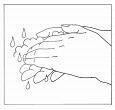
- 2. Prepare a clean, flat surface for mixing your Gonal-f® RFF vials. Place alcohol wipes on the surface within easy reach.
- 3. Using your thumb, flip off the plastic cap of the Gonal-f® RFF vial(s).
- 4. Wipe the top of the vial stopper with an alcohol wipe.
- 5. Remove the wrapping from the 18G 1-1/2" pink mixing needle.
- 6. Carefully remove the protective cap off the prefilled syringe labeled "sterile water for Injection, USP". Twist the mixing needle on the prefilled syringe until it is tightened and remove the needle cap.
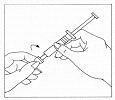
- 7. Position the 18G 1-1/2" needle of the syringe of water in a straight, upright position over the marked center circle of the rubber stopper on the vial of Gonal-f® RFF powder. Keep the 18G 1-1/2" needle at a 90 degree angle to the rubber stopper as you insert it through the center circle, or it may be difficult to depress the plunger. Slowly inject the water into the vial by depressing the syringe plunger.
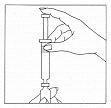
- 8. Leave the 18G 1-1/2" needle and syringe in the vial. Gently rotate the vial between your fingers until the powder is dissolved. Do not shake the vial. If bubbles appear, wait a few moments for the bubbles to settle. The liquid drug should be clear.
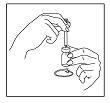
- 9. Draw the total contents of the vial into the syringe. If necessary, invert the vial and pull back the 18G 1-1/2" needle as far as needed to withdraw the entire contents of the vial. Remove the 18G 1-1/2" needle and syringe containing the solution from the vial.
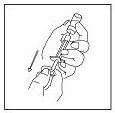
- 10. If more than one vial of powder medication is to be dissolved repeat steps 3, 4 and 7 to 9. A new alcohol wipe should be used to clean each vial. Use the same 18G 1-1/2" needle and syringe now containing reconstituted solution to reconstitute the additional vial(s). (Discard any other unused syringes of water for injection.)
- 11. Gently pull the plunger back to allow a small air space. Carefully recap the needle. Twist off the mixing needle from the syringe and discard safely.
Step 2: Determining your dose on the injection syringe
Your doctor will instruct you to take a specific dose of Gonal-f® RFF.
Step 3: Preparing your dose
- 12. Remove the wrapping from the 29G ½" red injection needle. Twist the injection needle on the syringe and remove the needle cap.
- 13. Invert the syringe with the 29G ½" needle for injection facing up toward the ceiling, gently tap the syringe, and push the plunger until all air bubbles have been expelled. This step may need to be repeated if all air bubbles are not expelled. Slightly depress the plunger until a drop of liquid is released from the tip of the needle.
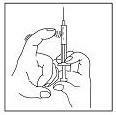
- 14. Recap the 29G ½" needle for injection while preparing the injection site. Carefully lay the syringe on a flat, clean surface. Do not touch the needle or allow the needle to touch any surface.
You should now be ready to prepare to receive the injection.
Step 4: Injecting your dose
Your doctor, nurse, or pharmacist should provide you with injection training. Inject the prescribed dose as directed. Usual injection sites include the skin on the stomach, upper arm, or upper leg. Change the injection location each day to minimize discomfort.

- 15. All needles should be disposed of in an appropriate needle disposal container as directed by the doctor.
Parenteral drug products should be inspected visually for particulate matter and discoloration prior to administration, whenever solution and container permit.
-
HOW SUPPLIED
Gonal-f® RFF (follitropin alfa for injection) is supplied in a sterile, lyophilized form in single-dose vials containing 82 IU with diluent (Sterile Water for Injection, USP) in a pre-filled syringe. Following reconstitution with the diluent as described, upon administration each vial will deliver a dose of 75 IU.
Lyophilized vials may be stored refrigerated or at room temperature (2°- 25°C/36°-77°F). Protect from light. Use immediately after reconstitution. Discard unused material.
Sterile Water for Injection, USP is provided in a pre-filled syringe. Separate needles are provided for reconstitution (18 G) and administration (29 G).
Note: No antimicrobial or other substance has been added to the Sterile Water for Injection for the single-dose vials. Sterile Water for Injection is not suitable for intravascular injection without its first having been made approximately isotonic by the addition of a suitable solute.
The following package combinations are available:
1 vial Gonal-f® RFF 75 IU and 1 pre-filled syringe Sterile Water for Injection, USP, 1 mL, 1 reconstitution needle (18 gauge), 1 administration needle (29 gauge), NDC: 44087-9005-1
10 vials Gonal-f® RFF 75 IU and 10 pre-filled syringes Sterile Water for Injection, USP, 1 mL, 10 reconstitution needles (18 gauge), 10 administration needles (29 gauge), NDC: 44087-9005-6 - SPL UNCLASSIFIED SECTION
- PRINCIPAL DISPLAY PANEL - 75 IU Vial Label
- PRINCIPAL DISPLAY PANEL - 1 mL Syringe Label
-
PRINCIPAL DISPLAY PANEL - Kit Carton
GONAL- f® RFF 75 IU
(follitropin alfa for injection)NDC: 44087-9005-6
For subcutaneous use
Rx only10 vials Gonal-f® RFF
10 pre-filled syringes Sterile Water for Injection, USP
10 18-gauge needles for reconstitution
10 29-gauge needles for administration
* revised formulation femaleEMD
Serono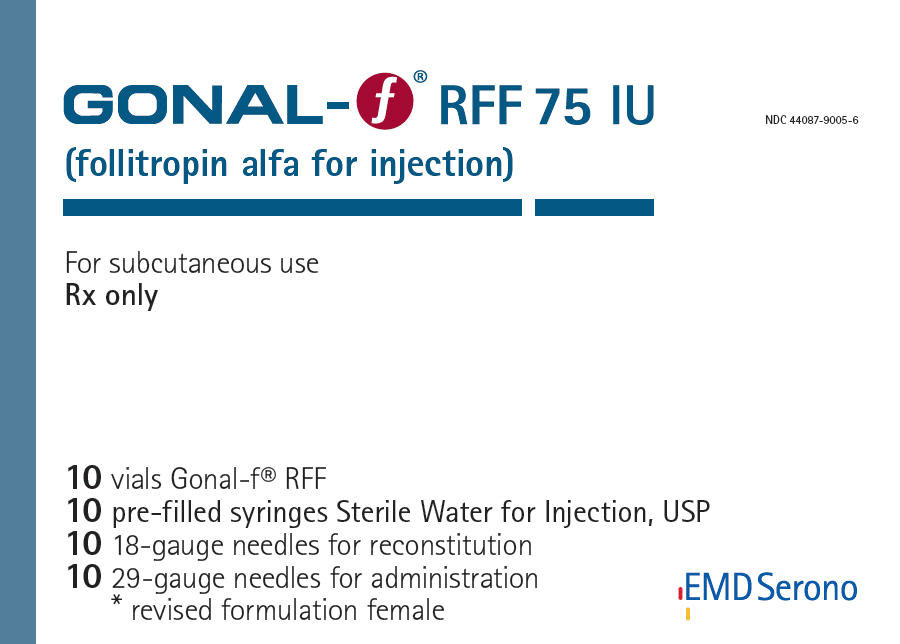
-
INGREDIENTS AND APPEARANCE
GONAL-F RFF
follitropin alfa kitProduct Information Product Type HUMAN PRESCRIPTION DRUG Item Code (Source) NDC: 44087-9005 Packaging # Item Code Package Description Marketing Start Date Marketing End Date 1 NDC: 44087-9005-1 1 in 1 CARTON 03/25/2004 1 1 in 1 BLISTER PACK 2 NDC: 44087-9005-6 10 in 1 CARTON 03/25/2004 2 1 in 1 BLISTER PACK Quantity of Parts Part # Package Quantity Total Product Quantity Part 1 1 VIAL, SINGLE-USE 1 mL Part 2 1 SYRINGE, GLASS 1 mL Part 1 of 2 GONAL-F RFF
follitropin alfa injection, powder, lyophilized, for solutionProduct Information Route of Administration SUBCUTANEOUS Active Ingredient/Active Moiety Ingredient Name Basis of Strength Strength FOLLITROPIN (UNII: 076WHW89TW) (FOLLITROPIN - UNII:076WHW89TW) FOLLITROPIN 75 [iU] in 1 mL Inactive Ingredients Ingredient Name Strength SUCROSE (UNII: C151H8M554) 30 mg in 1 mL SODIUM PHOSPHATE, DIBASIC, DIHYDRATE (UNII: 94255I6E2T) 1.11 mg in 1 mL SODIUM PHOSPHATE, MONOBASIC, MONOHYDRATE (UNII: 593YOG76RN) 0.45 mg in 1 mL METHIONINE (UNII: AE28F7PNPL) 0.1 mg in 1 mL POLYSORBATE 20 (UNII: 7T1F30V5YH) 0.05 mg in 1 mL Packaging # Item Code Package Description Marketing Start Date Marketing End Date 1 1 mL in 1 VIAL, SINGLE-USE; Type 1: Convenience Kit of Co-Package Marketing Information Marketing Category Application Number or Monograph Citation Marketing Start Date Marketing End Date NDA NDA021765 03/25/2004 Part 2 of 2 WATER
water injection, solutionProduct Information Item Code (Source) NDC: 44087-9998 Route of Administration SUBCUTANEOUS Inactive Ingredients Ingredient Name Strength WATER (UNII: 059QF0KO0R) 1 mL in 1 mL Packaging # Item Code Package Description Marketing Start Date Marketing End Date 1 NDC: 44087-9998-1 1 mL in 1 SYRINGE, GLASS; Type 1: Convenience Kit of Co-Package Marketing Information Marketing Category Application Number or Monograph Citation Marketing Start Date Marketing End Date NDA NDA021765 03/25/2004 Marketing Information Marketing Category Application Number or Monograph Citation Marketing Start Date Marketing End Date NDA NDA021765 03/25/2004 Labeler - EMD Serono, Inc. (088514898)
© 2025 FDA.report
This site is not affiliated with or endorsed by the FDA.
